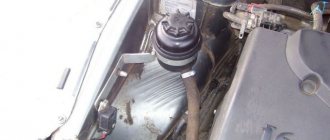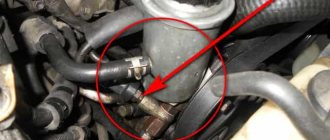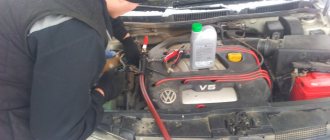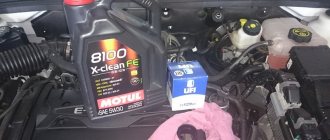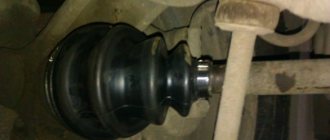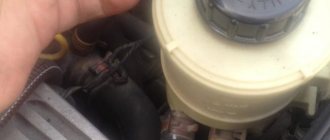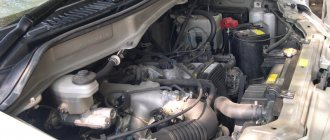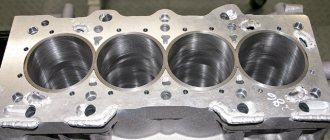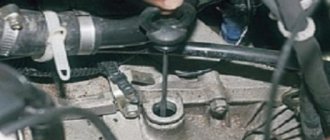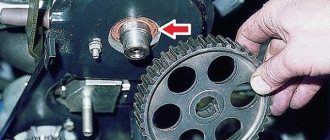The power steering on the Chevrolet Lacetti is quite reliable, not capricious and relatively rarely attracts attention. And it doesn’t need special attention - just check the fluid level in the tank and monitor the operation of the device while driving. However, sometimes you need to know what kind of oil to pour into the Lacetti power steering, whether it is possible to mix different brands and classes of fluids.
Power steering Lacetti
The Lacetti power steering is the main steering unit of this car, which requires special attention.
Let's consider its design and maintenance. The steering of the Chevrolet Lacetti is non-traumatic, with an adjustable steering column, rack and pinion steering and hydraulic booster. The Lacetti part is also equipped with a hydraulic power steering system with variable force on the steering wheel. The principle of operation of the system is based on changing the pressure of the working fluid in the pipelines depending on the speed of the vehicle, for which a valve is installed in the power steering pump housing, which is controlled by the electronic unit of the system. The higher the vehicle speed, the more the valve opens, as a result of which the pressure in the power steering lines drops and the force on the steering wheel increases. The steering system consists of a steering wheel, a steering column, a steering gear, two steering rods connected by ball joints with steering knuckles, pipelines and a pump. The rotation of the steering wheel through the steering column shafts is transmitted to the steering gear, which moves the steering rack, which turns the front wheels of the car through the steering rods. The power steering pump creates fluid pressure, which reduces the effort that the driver must apply to turn the wheels.
What is the liquid inside for?
The entire system is actually built on it, and it is precisely because of its pressure that comfortable steering is created. If you go, then the principle here is a syringe! “Oh, how,” you say, “why a syringe.” Yes, it’s all simple guys, it also has a body, a piston, and a rod connected to the piston that moves left and right. This is exactly how the steering rack is built!
Now imagine that you are feeding a liquid under pressure into the syringe, any ordinary water, say, the piston will begin to deviate. Also in a rack with a hydraulic booster, we pump liquid into the body, it alternately pushes the piston on either one side or the other, it deflects either to the right or to the left, depending on where you turn the steering wheel.
This pressure is created by a vane pump, and the liquid is stored in a special container. It is she who is entrusted with the main work, without her the system would not function!
It is worth noting that the pressure inside the rack is enormous, reaching 50 - 100 BAR (technical atmospheres). That’s why you can turn the steering wheel so easily, almost with just one finger, regardless of your physical fitness.
Power steering Lacetti. Device
The Lacetti power steering system is quite reliable, but it has one drawback - on most cars, after a certain mileage, a rustling or slight howl begins in the operation of the power steering. Also, do not hold the steering wheel in extreme positions for a long time to avoid increased wear of power steering parts.
Power steering Chevrolet Lacetti
1 — power steering pump; 2 - discharge line; 3 - filling line; 4 — power steering reservoir; 5 - drain line; 6 — steering wheel; 7 — steering column; 8 — intermediate steering shaft; 9 — intermediate shaft seal; 10 — hinge boot; 11 — steering mechanism; 12 — steering gear cover; 13 — left tie rod; 14 — right steering rod
What kind of power steering fluid for Chevrolet Lacetti?
DEXRON is used as the working fluid for the Chevrolet Lacetti power steering || and DEXRON |||. Therefore, it is necessary to use a replacement fluid with the same characteristics. Based on this, we purchase either the original GM Dexron III (II D) fluid or analogues from other manufacturers (SAE 75W-80, API GL-3/GL-4, Ford Mercon, Allison C4). The total volume of the Lacetti power steering system is 1.1 liters.
I used this working fluid
Power steering fluid for Chevrolet Lacetti
Addition! Some time after writing this article, I inspected the steering and power steering systems, which resulted in a leak of some fluid. But instead of topping up, I decided to change the fluid again. And I already filled it with DEXRON 6.
Number 8305504. It cost me 150 UAH. (5-6 American money). A liter bottle was enough for me. But that's not the point.
And the fact is that this liquid, according to my subjective feelings, is an order of magnitude superior to the one I poured in earlier. The steering wheel is much quieter, the steering wheel rotates easier, the slight vibration on the steering wheel has disappeared, the hourly fuel consumption has decreased by xx and my life has become more joyful
Mixed half a glass of old DEXRON ||| and the new Dexron VI - no reactions. I warmed it up a little and didn’t notice any reactions either. So, I think they are compatible.
I advise you to try it. The result over 400 km is only positive emotions. Especially relevant in cold weather!
But it is worth noting that the manufacturer does not establish any regulatory standards for replacing fluid in the Chevrolet Lacetti power steering. This means that the working fluid in the Lacetti hydraulic booster does not require replacement for the entire life of the car.
However, if you find that the color of the fluid in the power steering reservoir has changed and it has become dark, this is a sign that there is a malfunction in the power steering system and it needs to be repaired. After repairing the power steering of the Chevrolet Lacetti, completely replace the fluid and bleed the system.
Replacing fluid in the Lacetti power steering
- To allow the front wheels to turn freely, we hang up the front of the car. You can also drive your front wheels onto a slippery surface (wet grass, mud, ice, etc.)
- Open the lid of the power steering reservoir and use a large medical syringe to pump out all the liquid from it.
- Then we find two hoses under the tank. We disconnect the first one, which goes to the power steering pump, and place a previously prepared container under it and wait until the fluid stops leaking.
- Now we remove the other hose – the “return” hose. The photo shows the return hose with a red arrow, and the green arrow, which goes to the power steering pump.
How to change the oil in a Chevrolet Lacetti power steering
- We substitute the same container under the “return” and pump out the remaining fluid into the power steering of the Chevrolet Lacetti. To pump out all the old fluid from the system as much as possible, you need to turn the steering wheel all the way, first in one direction and then in the other, while making short pauses in extreme positions. This operation must be performed until the liquid stops leaking.
- You can also wipe the end of the hose that you removed first and blow into it.
- After this, connect the hose back to the tank and fill it with new fluid.
- We bleed the Chevrolet Lacetti power steering system:
- Do not start the engine. Again, slowly turn the steering wheel several times in different directions, with a slight delay in the extreme position. Be sure to make sure that the liquid in the tank does not fall below the level, so that air does not get in, and top up if necessary. We carry out this operation until the liquid stops decreasing.
- Now you can start the engine. Do not be alarmed if at first you hear noise in the area of the power steering pump, this is normal; when the liquid fills the entire system, it will disappear. With the engine running, repeat turning the steering wheel left and right, but without pauses and not all the way. We check the level and, if necessary, add oil until it is at the MAX mark when the engine is running.
Most often, the cause of noise and, in fact, the reason for repairing the Chevrolet Lacetti power steering system is the failure of the power steering pump.
Lacetti power steering pump
The pump replacement process is discussed in this article.
Power steering, oil in power steering Chevrolet Lacetti
The power steering is one of the main components of the steering mechanism. It reduces the force required to apply the steering wheel to make a turn.
This increases the comfort of driving the car, reduces driver fatigue and increases the safety of the car.
For normal operation of the power steering, it is necessary to timely change the oil and use a fluid that meets all the recommendations of the automaker.
Replacement
- We hang the front wheels of the car - later we will rotate the steering wheel from right to left to pump the power steering system
- It is necessary to pump out all the fluid from the power steering reservoir using a syringe
- We remove the return hose from the power steering reservoir (the hose that is closer to the car interior) and lower it into some container, since power steering fluid will still flow out from there
- We sit in the cabin and turn the steering wheel left to right (from lock to lock) at least 10 times. We DO NOT start the engine!
- Let's see how much fluid has flowed out of the return hose of the power steering system. After this, we rotate the steering wheel 5 more times from lock to lock and again check how much fluid has flowed out. If the level has increased significantly, then you can repeat the procedure by rotating the steering wheel; if the level has remained virtually unchanged, then this is enough.
- It is advisable to remove the power steering system reservoir and the reservoir cap from the Lacetti and rinse it of old fluid
- Reconnect the system return clamp to the tank and fill the tank with new oil to the MAX level.
- We turn the steering wheel from side to side again, DO NOT start the engine and monitor the fluid level in the tank. Don't let it drop below the MIN mark
- Add oil as needed
- When the oil stops decreasing from the reservoir (the power steering system is almost full), you can start the engine and turn the steering wheel again from lock to lock until the fluid stops decreasing from the power steering system reservoir
The power steering is one of the main components of the steering mechanism. It reduces the force required to apply the steering wheel to make a turn.
This increases the comfort of driving the car, reduces driver fatigue and increases the safety of the car.
For normal operation of the power steering, it is necessary to timely change the oil and use a fluid that meets all the recommendations of the automaker.
Typical problems with power steering on a Chevrolet Lacetti
During the operation of the Chevrolet Lacetti, many car owners are faced with the fact that the steering wheel becomes heavier. The most common reason why power steering does not work is a critical decrease in the level of working fluid.
Airing of the circuit may also be observed. A particular situation with a heavy steering wheel is that it gets wedged in the central position. In this case, it is necessary to check the wear of the steering rack working cylinder.
Often, during operation of the power plant, you can hear the power steering pump humming. This is caused by damage to the bearing or impeller.
Another problem with the power steering is fluid leakage from its circuit. Oil that has leaked through the pump or its gasket can get onto the pulley and then onto the drive belt. It is not made of oil-resistant rubber, so contact with working fluid on the belt leads to its destruction, which may result in repairs to the power plant.
The system may also lose its tightness due to leaky pipes or the power steering reservoir. A decrease in pressure leads to airing of the system and increased wear of the steering mechanism elements.
So what is better to pour?
Guys, you can’t experiment here, you need to follow the tolerances that the manufacturer shows you. After all, any incorrect oil or composition can turn your power steering into a jammed unit! This needs to be remembered; there are a few simple rules that will help you in your choice:
- Compliance with the car brand. We select it specifically for your car.
- Mixing only with similar compounds
- Withstanding high temperatures, you need to pay attention to this, because oils can heat up to quite high levels, especially in summer. As some manufacturers recommend, they should be kept at approximately 100 degrees Celsius.
- Fluidity. For many machines, you need really liquid compounds, otherwise the pump simply won’t pump.
- Liquid resource. How long should it work at maximum?
As you can see, the requirements are really stringent, which is why ATF fluids from automatic transmissions are often used; they are durable, can withstand high temperatures, and are available for mixing.
What else would I like to say in conclusion, many people do not change the fluid for years until the rack starts leaking! Guys, this is not correct, because it also wears out, loses its properties, precisely because of its wear, and the anthers may tear, because lubrication will not occur as needed. Therefore, in order to extend the service life of the hydraulic booster, it is PREFERABLE to completely change the fluid every two to three years!
Troubleshooting common problems
If during operation of the Chevrolet Lacetti a problem is detected with the power steering, then repairs can be performed using the algorithm below.
- The first step is to check the power steering fluid level. If it is below or close to the minimum, then add oil. In many cases this helps solve the problem.
- After a certain period after adding fluid, its level should be checked. A significant decrease in it indicates depressurization of the circuit. Troubleshooting must begin with a visual inspection. Troubleshooting depends on the failed unit, but in most cases requires replacing parts.
- If adding working fluid does not restore normal operation of the power steering, then it is necessary to check the pump. Troubleshooting is most conveniently done by ear. When the power plant is running, there should be no extraneous noise from the pump in the form of hum, whistle, squeak, or crackling. The pump has low maintainability, so in most cases it must be replaced with a new one.
Choosing oil for filling in power steering Chevrolet Lacetti
The original power steering fluid is GM Dexron VI. This oil is filled from the factory. General Motors products have article number 1940184. Its price starts from 650 rubles. By purchasing the original fluid, the car owner receives a number of advantages:
When switching to power steering fluid from a third-party manufacturer, simply adding and mixing oils is prohibited. Therefore, before filling in the newly acquired liquid, it is necessary to flush the circuit. The best options for alternative oils are shown in the table below.
Table - List of analogues of the original Chevrolet Lacetti power steering fluid
| Brand | Approximate cost ruble |
| LUKOIL ATF SYNTH VI | 310 |
| MANNOL ATF Dexron VI | 400 |
| ZIC ATF | 210 |
| KROON OIL SP Matic | 480 |
| TOTAL FLUIDMATIC MV LV | 470 |
Liquid composition
Based on the composition of the power steering fluid, it can be divided into mineral, semi-synthetic and synthetic. The chemical composition determines the basic set of oil functions:
- Viscosity characteristics;
- Lubricating properties;
- Protection of parts from corrosion;
- Prevents foaming;
- Temperature and hydraulic properties.
Synthetics and mineral water cannot be mixed with each other, since the types of additives in them have fundamental differences.
These are high-tech liquids, in the production of which the most modern developments and additives are used. Oil fractions for synthetics are purified by hydrocracking. Polyesters, polyhydric alcohols and sets of additives give them outstanding characteristics: a wide range of operating temperatures, stable oil film, long service life.
The main reason why synthetic-based hydraulic fluid cannot be poured into power steering intended for mineral ones is its aggressive effect on rubber products, of which there are many in the hydraulic booster. Where synthetics are used, the rubber has a completely different composition and is made on a silicone basis.
Semi-synthetics
A mixture of synthetic and mineral oils, due to which the latter receive significant improvements in performance: reduced foaming, fluidity, heat dissipation.
Semi-synthetic fluids include such well-known fluids as: Zic ATF Dex 3, Comma PSF MVCHF, Motul Dexron III and others.
Mineral-based oils contain petroleum fractions (85-98%), the rest are additives that improve the performance of the hydraulic fluid.
They are used in hydraulic boosters containing seals and parts based on ordinary rubber, since the mineral component is neutral and is not harmful to rubber products, unlike synthetics.
Mineral power steering fluids are the most inexpensive, but they also have a short service life. Mobil ATF 320 Premium is considered a good mineral oil; Dexron oils up to and including the IID marking were also mineral.
Power steering oil change intervals
General Motors does not standardize the mileage or time interval when you need to change your power steering fluid. Car owners are advised to check the oil level every 10-20 thousand km. Fluid replacement is necessary after 60-100 thousand km. When determining the need to fill in new fluid, it is more correct to focus on the following reasons:
- the appearance of extraneous sounds during turns;
- significant change in liquid color;
- burning smell that comes from opening the power steering reservoir;
- heterogeneity of the working fluid;
- jamming when turning the steering wheel;
- the appearance of deposits on the walls of the tank.
Required Tools
In order to replace the working fluid of the Chevrolet Lacetti power steering circuit, you will need the tools listed in the table below.
Table - List of tools that will be needed when changing power steering oil on a Chevrolet Lacetti
| Name | Note |
| Jack | 2 pcs. For hanging the front of the car. When lifting the car on a lift, there is no need for jacks. If you don't have a second jack, you can use supports. |
| Syringe | More than 10 cm 3 |
| Hose | For more comfortable drainage of liquid. |
| Key | "on 10" |
Replacing power steering fluid on a Chevrolet Lacetti
In order to change the power steering oil yourself, you need to use the instructions below.
- Secure the vehicle with the parking brake.
- Raise the front end using a jack. Place stops. Nothing should interfere with the turning of the wheels.
- Open the hood.
- Remove the cap from the power steering expansion tank.
- Using a syringe, pump out as much liquid as possible from the expansion tank. If this is not done, then during the oil change process there is a risk of dirtying the power plant.
- Assess the condition of the expansion tank walls. If they are coated or heavily soiled, then it is necessary to remove the second hose and dismantle the liquid container. After this, you should wash the walls using special means. Next, you need to return the reservoir to its place and connect the hose going to the power steering pump.
- Place the return hose into an empty container.
- The fluid is replaced by displacing it. Therefore, it is necessary to fill the expansion tank with oil to the maximum possible level.
- Intensively turn the steering wheel in different directions to extreme positions. At this time, old fluid will flow from the return hose. It is important to ensure that the oil in the expansion tank does not drop below the minimum mark. Otherwise, the system will become airy.
- As soon as fresh oil flows from the return, return the hose to its place.
- Bring the fluid level to the maximum level.
Instructions for replacing power steering fluid for Chevrolet Lacetti and Cruze
The power steering is the main component in the control system of any car. In order for the power steering to always work correctly, it is necessary to monitor the condition of its parts and mechanisms, as well as promptly change the working fluid in the system. How to replace the Lacetti power steering fluid and in what cases the oil needs to be changed - find out from this material.
Different types of oils
Dexron is a separate class of ATF fluids from General Motors, produced since 1968. Dexron is a trademark, produced both by GM itself and by other companies under license.
ATF (Automatic Transmission Fluid) - oils for automatic transmissions, often used by Japanese automakers and in power steering.
PSF (Power Steering Fluid) - literally translated as power steering fluid.
» alt=»»> Multi HF - special, universal power steering fluids that have approvals from most automobile manufacturers. For example, CHF liquid, produced by the German company Pentosin, has received approvals from BMW, Ford, Chrysler, GM, Porsche, Saab and Volvo, Dodge, Chrysler.
How to determine the need to change the power steering oil?
On the Chevrolet Lacetti, Chevrolet Cruze and many other models of this manufacturer, power steering fluid is an important consumable, the condition of which determines the operation of the unit as a whole. Unfortunately, the technical regulations do not indicate the exact timing of oil changes, but many car enthusiasts claim that after 15 thousand kilometers the fluid should be changed in any case (video author - Nikita Kislyakov).
What signs may indicate the need for an oil change:
- the liquid has changed its color, become darker, and may contain sediment;
- consumables smell like burning;
- the steering wheel has become more difficult to turn;
- When turning the steering wheel, sounds uncharacteristic of its operation may be heard.
What kind of fluid to pour into the power steering
Based on this, the answer to the question “what kind of oil to pour into the power steering” is obvious - recommended by the manufacturer of your car. Often information is indicated on the expansion tank or cap. If there is no technical documentation, call an authorized center and ask.
In any case, experiments with steering are unacceptable. Not only your safety, but also that of those around you depends on the health of your power steering.
Oil Change Guide
So, changing the power steering oil is an integral part of the maintenance of a Chevrolet Lacetti. The fluid replacement procedure can be performed at home.
What the replacement process looks like:
- First, you will need to jack up the front of the car, this is necessary so that the front wheels can rotate freely. If you don’t have jacks, then as an option, you can use a slippery surface, for example, ice, wet grass, etc.
- Next, open the hood and unscrew the filler plug of the power steering reservoir. Using a large medical syringe with a nozzle installed on it, it is necessary to pump out all the consumables from the tank.
- After that, look under the tank - there should be two pipes along them. The pipe that connects to the power steering pump must be disconnected, but before doing this, place a container under it, for example, a cut-off bottle. You need to wait until all the oil has left the system.
- Next, disconnect the second pipe - this is the so-called return pipe. The return line is marked in more detail in the photo. You also need to place a container under this hose, since oil will also come out of it. In order to pump out spent consumables from the power steering system as much as possible, the car’s wheels must be turned first completely to the right, and then completely to the left. In this case, in extreme positions it is necessary to pause for several minutes. This procedure is repeated until oil stops coming out of the return line.
- When the substance comes out, wipe the end of the first pipe you removed and try blowing into it. If there are any remaining consumables in the system, they must come out.
- Next, the pipe itself should be connected back to the expansion tank. After completing these steps, you can fill the tank with new consumables. In this case, the volume of the substance poured must correspond to the volume of drained oil, no more and no less. When filling, be guided by the marks marked on the tank - the volume of substance in it should be at a level between MIN and MAX.
- When the substance is poured, the power steering system is pumped. This stage is very important and cannot be skipped. Follow the instructions strictly, as these steps largely determine the effectiveness of the work done.
- So, with the engine turned off (don’t even think about starting it), you need to slowly turn the steering wheel to the right and left, to the extreme position. In this case, in each extreme position the steering wheel should be held for a few seconds, as you did earlier. When turning the steering wheel, make sure that the level of consumables in the expansion tank does not drop to a minimum. It is also advisable to prevent air from entering the system, otherwise this will cause the formation of an air lock. And this, in turn, will cause a hum and noise when turning the steering wheel, so be careful. If the volume of a substance decreases as a result of manipulation, it will need to be replenished. The procedure is repeated until the level of the substance in the expansion tank stops decreasing.
- After completing these steps, you can start the power unit. Immediately after starting, you can hear the power steering pump humming. Some car enthusiasts immediately check the pump, the pump itself and other elements of the system, but this is unnecessary, since the appearance of sound initially after replacement is normal. When the substance disperses throughout the system, all noise should disappear. When the engine is running, the procedure of turning the steering wheel to the extreme right and left is repeated, only there is no need to pause. Check the level of consumables in the expansion tank again and, if necessary, add the substance.
Photo gallery “Do-It-Yourself Replacement”
Price issue
The cost of consumables will depend on the manufacturer, as well as the quality of the substance. For example, the cost of one liter of MOTUL Dexron IID today is about 600 rubles. A product that meets the same characteristics, only from the manufacturer Febi, costs around 420 rubles per liter, and from the manufacturer Castrol - approximately 520 rubles per liter.
Replacing power steering fluid for Chevrolet Lacetti and Cruze: how much and what oil to pour into the power steering?
Power steering hums.
Therefore, the original fluid can be replaced with any suitable standard, and GM recommends Dexron.
Chevrolet Cruze Base Kukuruz › Logbook › Fluid in power steering Chevrolet Cruze. Any Dexeon oil...
Therefore, the original fluid can be replaced with any suitable standard, and GM recommends Dexron.
We check the level and add fluid if necessary until it is at the MAX mark when the engine is running. We won’t take risks, but remember that mixing synthetics and mineral water in power steering is strictly not recommended.
Frankly speaking, the composition of this oil differs from the industrial spindle that is piled up at every machine plant, only in a set of additives, and the price is not dictated by the proletarian origin of the oil. The color of the liquid is initially red, but over time it can change greatly.
Color classification
It is wrong to be guided only by color gradation when choosing oil, although this practice is widespread among car owners. It is also often indicated what color liquids can be mixed and which ones should not be mixed.
Mixing is contraindicated with liquids based on composition and not color, and since now both mineral water and synthetics can be presented in any color, you should treat this information very carefully.
Red ATF gear oil is usually synthetic, the Dexron brand from General Motors is considered the standard, but there are products from other manufacturers, such as Revenol, Motul, Shell, Zic, etc.
Yellow oil, produced by the Daimler concern and under its license, is used in Mercedes-Benz hydraulic boosters. It can be synthetic and mineral.
Green oil. For the most part, multifunctional and universal liquids can be either synthetic or mineral in composition. They are used in power steering, suspension and other systems that operate on liquids. It cannot be mixed with other colors, except in cases where the manufacturer declares full compatibility, for example Comma PSF MVCHF is compatible with some types of Dexron.
Answers (2)
This will indicate that it is time to change the oil. Nevertheless, the manufacturer insists that the oil is filled for the entire service life of the car, although experienced Lacetti owners change the fluid every 50-60 thousand km.
A change in the color of the power steering fluid indicates that it is time to change it. If we decide to change the fluid completely, then we will definitely flush the system before filling - there is a possibility of mixing the fluids with different additives, which can cause foaming or sedimentation.
This will definitely affect the stability of the power steering. We remove the pipes and remove the tank to rinse it from plaque. Fill the liquid up to the MAX mark. Turn the steering wheel and add fluid.
If you don’t have jacks, then as an option, you can use a slippery surface, for example, ice, wet grass, etc. Next, open the hood and unscrew the filler plug of the power steering reservoir.
Using a large medical syringe with a nozzle installed on it, it is necessary to pump out all the consumables from the tank. After that, look under the tank - there should be two pipes along them.
The pipe that connects to the power steering pump must be disconnected, but before doing this, place a container under it, for example, a cut-off bottle.
You need to wait until all the oil has left the system.
Next, disconnect the second pipe - this is the so-called return pipe. The return line is marked in more detail in the photo.
Comments and reviews
You also need to place a container under this hose, since oil will also come out of it. In order to pump out spent consumables from the power steering system as much as possible, the car’s wheels must be turned first completely to the right, and then completely to the left.
In this case, in extreme positions it is necessary to pause for several minutes. This procedure is repeated until oil stops coming out of the return line. When the substance comes out, wipe the end of the first pipe you removed and try blowing into it.
If there are any remaining consumables in the system, they must come out. Next, the pipe itself should be connected back to the expansion tank. After completing these steps, you can fill the tank with new consumables. In this case, the volume of the substance poured must correspond to the volume of drained oil, no more and no less.
When the substance is poured, the power steering system is pumped.
This stage is very important and cannot be skipped. Follow the instructions strictly, as these steps largely determine the effectiveness of the work done.
How and with what can you mix it?
The question is complex, however, there are few hints from manufacturers regarding power steering oils. Now there are only three main colors of liquids, red, green and yellow. They differ approximately as follows:
- Red color
. Often this is a liquid that is used in automatic machines, currently the most advanced, mainly consisting of synthetic compounds.
- Yellow color
. In fact, it is also oil for automatic transmissions, but here it is more universal; it can be poured into both power steering and automatic transmissions. Minerals are mainly used. - Green
. One of the very first compositions. It can be either mineral or synthetic. It can also be poured into the hydraulic booster and transmission, however, only mechanical, not automatic transmission. More viscous composition.
Mixing - personally, I would never experiment, that is, I would pour my own oil that was filled with me! But anything can happen - it is usually recommended (allowed) to mix two types that are close to each other, for example, red and yellow. Nevertheless, both of them can be used in automatic transmissions. If green is added to the power steering, then it can only be mixed with itself; neither red nor yellow will suit it! Because it is also designed for mechanical transmissions, but there are other characteristics.
